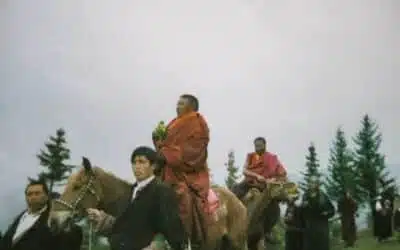The Friend of Good 2

Written By Mila Khyentse
Blog | General Introduction to Dzogchen | The Dzogchen basics
In “The Friend of Good 2, Dzogchen and its relation to Western traditions”, Mila Khyentse talks about the figure of the master in the West.
The Friend of Good 2: Dzogchen and its relation to Western traditions
The Western world is no exception when it comes to the tradition of the figure of the Master or Friend of Good, as we discussed in the first article of this series.
As in the Indian world, societies in the Western European cultural area were structured on a tripartite basis.
First, the Celts, whose three functions – clergy, nobility and people – as defined by Françoise Le Roux and Christian J. Guyonvarc’h and enshrined in the theories of Dumézil, hierarchized society. The representatives of the clergy, the druids, were responsible for the link with the gods, the invisible world of the living and the afterlife, but also for knowledge and education in a broader sense, especially the relationship with nature. As in the Vedic world, it was the sacred and priestly function par excellence, and the one with the most prestigious aura, as it was linked to the “spiritual world”. Apprenticeship was from master to disciple, within or outside the same clan.
In the Mediterranean world, among the Etruscans and Romans, who were also influenced by the Indo-Europeans and Greeks, the sacred function was also the prerogative of “specialists” who received special training from their master (the previous ritual leader) to perform the rite based on a strict execution of gestures (orthopraxy) determined by tradition. In fact, Roman religions were almost entirely ritual-based, with virtually no beliefs or dogmas other than those governing the relationship with the gods and the rituals addressed to them. In Rome, as in Vedic or classical India, the transmission from master to disciple was particularly concerned with the precision of the gesture.
Yet Dzogchen, like so many other traditions, insists on authentic, living transmission through experience and proximity. What is transmitted is the experience of a lifetime of practice, research and reflection from master to disciple.
At the end of the Roman period, another spiritual figure came to the fore, that of the emerging Christian world. It was this model that became “official” under the Emperor Constantine and was later imposed throughout the Roman West in the wake of the upheavals caused by the “barbarian invasions”. The social structure developed and was strengthened by the three functions we have already discussed. It was the Carolingian dynasty that definitively established the three orders of medieval society: laboratores (workers), bellatores (warriors) and, at the top, qui orant (those who pray). Here, too, the sacred function is considered paramount. Two main figures of the sacred function were then established: that of the monk, the regular clergy, and that of the priest, the secular clergy.
The image of the master is very strong, especially in monasticism, where the novice follows an “elder”, serving him while learning from him. Umberto Eco describes this very well in The Name of the Rose. However, this master-servant relationship can also be found elsewhere, notably in knightly orders (knight and squire), cathedral builders (master and apprentice), and so on.
This master-disciple relationship was one of the mainstays of Ancien Régime society. It was the very basis for the transmission of knowledge, whether sacred or secular. True knowledge, as in traditional societies, was mainly oral and therefore directly transmitted.
The rabbinic tradition, which was very strong throughout Europe in the Middle Ages (and is still very much alive today), is also very familiar with this master-student relationship. You learn sacred or secular texts at the feet of your master, refining your knowledge and wisdom through fruitful dialogue. To become a “disciple of the wise”, the student benefits from the living breath of his master and makes it his own.
Then came the French Revolution, another turning point in history that reshuffled the social deck, in particular by overturning the principle of the three functions.
The modern world, especially through the Age of Enlightenment, developed the hierarchical relationship in Western society, but always remained attached, in a slightly different way, to the essential relationship of master and disciple, especially in philosophy.
It wasn’t until the twentieth century, with schools for all and the technological revolution, that the cards were reshuffled. A great deal of knowledge became definitively “civil” and accessible in a relatively open way: the master was now the schoolmaster, and the relationship we have with him is not at all that of the Middle Ages. Nevertheless, the traditional master-disciple relationship continues to exist within religions, although it is changing with the direction taken by modernity.
The twenty-first century has seen the rapid development of knowledge for all and by all. We can now learn almost anything(?) through courses that are increasingly dematerialized. We are thus moving further and further away from what has been one of the foundations of human society almost since its origins.
This latest evolution in transmission and knowledge, sacred and/or secular, means that we feel we have increasing access to knowledge that requires less and less of an origin, and a human origin at that.
Yet Dzogchen, like so many other traditions, insists on authentic, living transmission through experience and proximity. What is transmitted is the experience of a lifetime of practice, research and reflection from master to disciple. As the saying goes, “like water from one vase poured into another”. It’s the same thirst-quenching water, whatever the container. For us, of course, the question is not whether teaching can be carried out in a dematerialized way, but rather whether the Great Perfection – or any other primordial teaching – can be transmitted without a master. What then would be the nature of the experience transmitted if not by someone who has experienced it directly? Perhaps, in fact, the real question is not whether or not the master-disciple relationship is important, but rather how this relationship should be clarified.
The debate seems to be raging in today’s modern Western society.
It’s not a debate in the Great Perfection…
More Posts
Stories When the Light Fades
In “Stories When the Light Fades”, Mila Khyentse recalls some of his Master’s Jack-o’-lantern stories told at night.
The ground (gzhi)
This article is the first in a new category designed to provide a better understanding of the essential words and concepts of Dzogchen.
The Call of the Lineage
In “The Call of the Lineage” Mila Khyentse talks about the Dzogchen lineage of his master Alags Chörten, called “the Diebu Lineage”.




